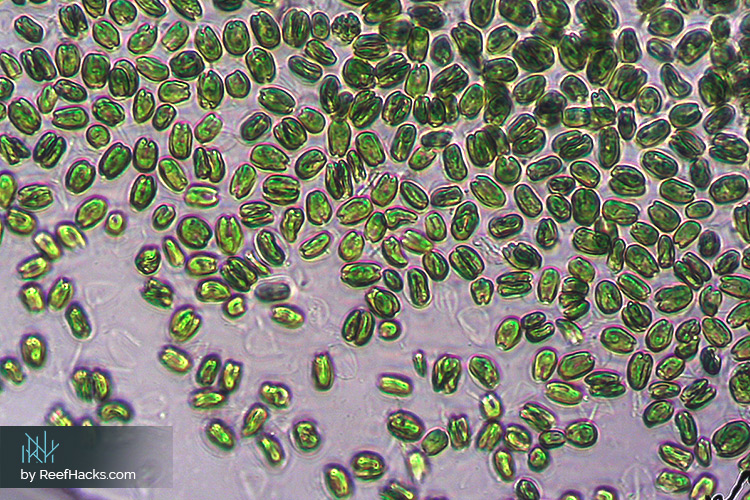Featured Image: Tetraselmis suecica(4-6um) single cell swimmer.
I heard a Local Fish Store owner tell a customer that ”All phytoplankton are the same”. My immediate thought was, are all corals the same? Are all fish the same? NO! There are conservatively hundreds of thousands to a million different species of phytoplankton in the oceans and more than that when we include freshwater phytoplankton.
Some phytoplankton are green, others are red, others brown; some move through the water column while others float; some are big, others small; some make chains of cells and are communal while others are solitary, and some glow in the dark. These differences extend to the nutritional values and compounds they offer as they pass through their different life stages.
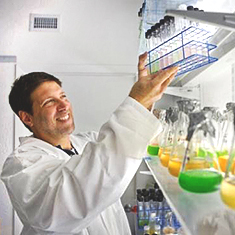
Author:
Erik Stenn is the founder and CEO of AlgaGen LLC. His educational background includes an Msc degree in Marine Microbial Ecology from Oregon State University and his experience encompasses more than 30 years of marine aquaculture projects around the globe. He started AlgaGen LLC – a Marine Biotechnology company - in 2002. AlgaGen has one of the largest accessible culture collections of copepods in the world and has been an active partner in numerous research projects to breed and raise Sea Horses, Weedy & Leafy Sea Dragons, Anthias, Tuna, and many other fish species as well as Coral health and growth studies.
AlgaGen is also an industry leader in the production of Phytoplankton. Currently, AlgaGen has several different strains in continual production for the Aquarium, Educational & Institutional industries. Clients include New England Aquarium, Georgia Aquarium, Steinhart Aquarium, Dallas World Aquarium, Monterey Bay Aquarium, Florida Aquarium, MIT, Harvard, Brown, Yale, Stanford, Mote Marine, Harbor Branch Oceanographic, Oceanic Institute Hawaii, FIT, FSU, U. Miami, FAU, Scandia National Labs, ORA, ProAquatix, Sustainable Aquatics, UF Tropical Aquaculture Lab, Exxon, and many more. Website: http://www.algagen.com
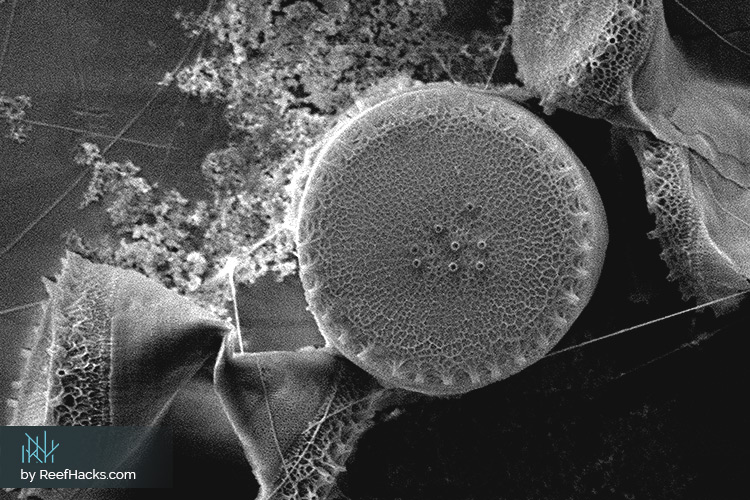
An Exploration Into Phytoplankton - What You May Not Know.
Did you know that the fatty acids produced during fast healthy phytoplankton growth are very beneficial and critical to the health of many marine organisms? In contrast, the fatty acids produced as the cells become old are better suited for biofuels and possess less nutritionally value. Some species of phytoplankton will produce harmful algal blooms (HABs) as a way of sequestering their environment.
Dinoflagellates and some diatoms are known to produce serious neurotoxins associated with fish kills as well as human illness and death. On the other hand Cyanobacteria have been credited with producing the oxygen necessary to build our atmosphere. No, not all phytoplankton are the same!
Phytoplankton are incredibly important to the aquatic food chain. They utilize nutrients in the water along with carbon dioxide to reproduce, and in the process, create essential fatty acids (EFAs) critical to the health and development of most marine organisms and people too (Omega 3 fatty acids-fish oils).
The phytoplankton utilize nitrates and phosphates, iron and other trace elements to produce proteins and essential fatty acids. The phytoplankton in turn are consumed by filter feeders and aquatic bugs like copePODS which pass these essential fatty acids on to fish and other predators.
In larval studies, those larvae fed phytoplankton high in specific fatty acids (such as DHA) developed better, less mortalities, less deformities than larvae fed other feeds deficient in these fatty acids. In aquaculture only a handful of phytoplankton species are used because that is what has been studied and documented.
Since there are 100’s of thousands in nature, it is quite possible that there are phytoplankton species even better than those used currently. No, not all phytoplankton are the same!
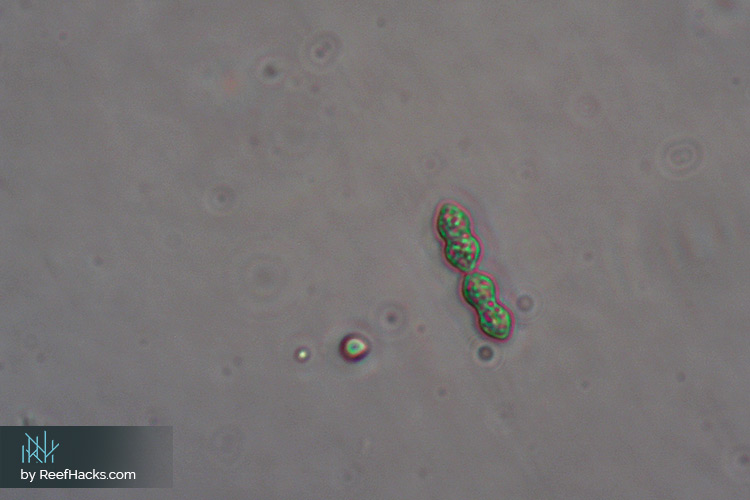
Synechococcus (1-2um) -this is a cyanobacterium but NOT the one that causes trouble for reefkeepers - single cell and chain forming and floater.
Unleashing Oceanic Beauty at Home - The Role of Phytoplankton.
The question comes up as to why phytoplankton is not more widely used throughout the hobby, such as in home aquariums? It may be that the aesthetic we are trying to mimic are the crystal clear waters of the Caribbean? Or that, hobbyists will not add brown phytoplankton in fear that it will make their tank look like a “cess pool”; Isochrysis galbana (T. ISO), a brown motile alga, was isolated off a dock in Tahiti.
I met the guy who isolated the T. Iso strain of phytoplankton at an algal conference. He told me that there had been a beautiful reef at the end of the dock where he found the strain…just sayin’.
In today’s marketplace, there are more phytoplankton products than ever. Accessibility should not be an issue one just needs to decide which one to use.
Phytoplankton are cultured by protocols developed by Provosoli and Guillard in the 1960s and really, these protocols have changed little since then. These scientists developed a specific marine nutrient formula, F-media, designed to grow phytoplankton and mimic nutrients in the ocean necessary for phytoplankton growth.
Sometimes we hear of people using terrestrial plant fertilizers with the argument that all fertilizers are the same-not so either! Some terrestrial fertilizers are heavy in copper or other trace elements, which could be toxic to corals and even algae. Cutting corners by using cheap terrestrial fertilizers to grow phytoplankton could wipe out a tank. Not all fertilizers are the same!
The Secret Source of Reef Tank Health With Nature’s Cleaning Crew.
Fine, so practically how does one use phytoplankton and what should be expected with its use? The continuous, consistent use of phytoplankton will have positive impacts on the tank ecosystem.
It has been observed that corals consume phytoplankton whether intentionally or incidentally. Gorgonians, carnations, pagodas and many others benefit from the presence of phytoplankton. Many invertebrates require it, certainly copepods do. Amphipods can exist on phytoplankton, so can rotifers and brine shrimp. In short, with consistent, predictable use of phytoplankton there will be more aquatic bug life; better aquatic bug life means more food for corals and fish.
Many of the aquatic bugs generally eat detritus, thereby keeping the tank cleaner-naturally. Live phytoplankton are used in aquaculture to absorb and bind heavy metals. In this case the use of live phytoplankton will clean the water and lead to healthier corals and fish even if it is not used as a food source directly.
Live Phytoplankton will also remove nitrates and phosphates, consume carbon dioxide (stabilize pH) and oxygenate the water during the day part of the light cycle.
Conservative advice is to start off with the addition of a minimal dose once per week and build up to several times per week. The gradual increase in feeding phytoplankton gives your system time to adjust to the phyto’s presence. Dosing phytoplankton is not formulaic.
It is hard to say definitively that one should add a set amount to a set volume. On some level trying to mimic nature with the exact amount of phytoplankton found in nature is not practical from a cost standpoint. The dose amount you decide upon will vary based on which organisms are in the tank, how many organisms are in the tank, the aquatic environment you are trying to emulate, skimming, water changes, etc.
Dosing will also depend on the specific phyto product you purchase. Some phyto products have high concentrations of phyto while others have very lite concentrations, some are live and others are not…all these factors need consideration. Dosing can be performed manually or one can get creative and automate it.
Some companies have developed creative solutions to dosing plankton; drip lines, pumps, overflows, etc.
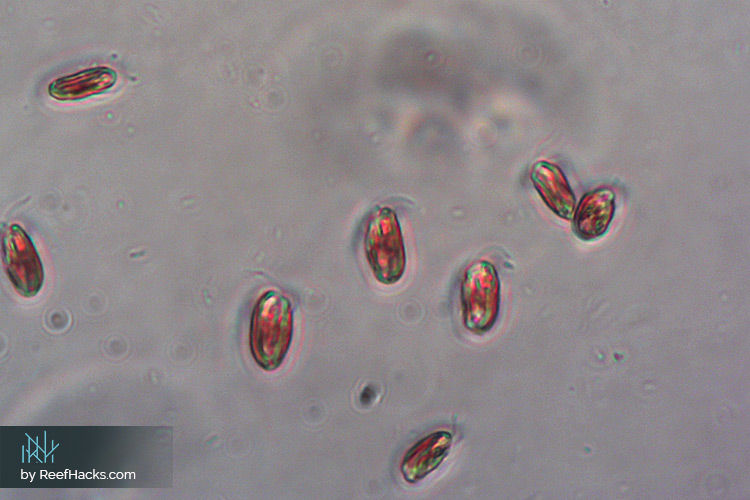
Rhodomonas lens (4-6um) single cell swimmer.
Navigating the Depths of Reef Tank Health - Choosing The Best Phytoplankton Source.
For years now AlgaGen has produced a line of bottled phytoplankton called PhycoPuretm; PhycoPuretm;Greenwater, PhycoPuretm CopepPOD Blend , PhycoPuretm Reef Blend and PhycoPuretm Zooxanthellae . These bottled phytoplankton products are meant to offer a convenient approach to feeding phytoplankton.
In 2017, AlgaGen developed frozen cubes of phytoplankton, PhycoPuretm; SeaPro, that are live and can be re-cultured after being thawed. It is literally live algae upon demand.
PhycoPuretm Reef Blend is a diverse composition of phytoplankton based on strains used successfully to grow marine animals; copepods, shrimp, oysters, clams, scallops, and corals amongst others. The species of phytoplankton in Reef Blend consist of a variety of sizes, nutritional properties, colors and culture parameters, it even contains a symbiont, zooxanthellae.
Zooxanthellae is critical to the health of photosynthetic corals. Over the years we have noticed such a positive response from hobbyists who have used this product routinely and responsibly, that we created a pure zooxanthellae product , PhycoPuretm Zooxanthellae.
This product was intended for those people solely interested in coral propagation and health. The PhycoPuretm Reef Blend is stored in the refrigerator and dosed as desired whereas the PhycoPuretm Zooxanthellae is dosed all at once. It is best to turn off the skimmer for a period of time to let the Phytoplankton (algal cells) disperse and contact the environment.
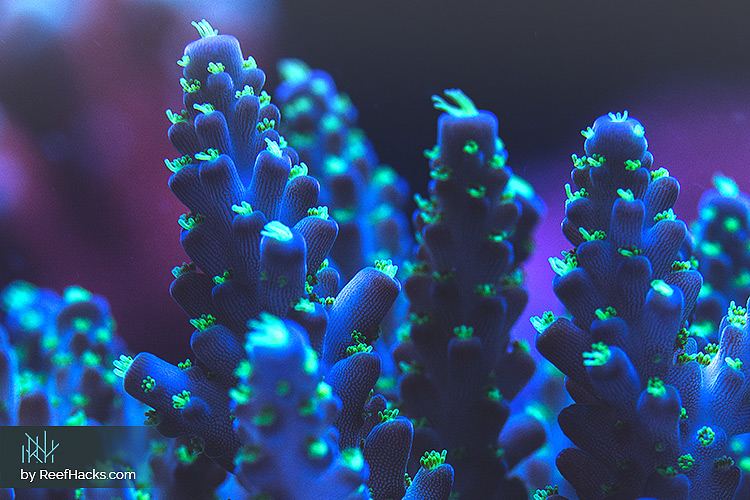
Achieving Health, Beauty and Vitality - Phytoplankton for Reef Tanks.
There are camps of belief that adding phytoplankton is just adding “nutrient”. Some aquarists will not use Phytoplankton at all, others will use gallons at a time; both approaches create beautiful tanks. Stay tuned, in the next article we will look at individuals who have placed great value on phytoplankton as part of their reef keeping routine. These individuals, are having great success by pushing the limits of how much phytoplankton to dose and experimenting with what their system can handle.
Someone told me that the use of phytoplankton to them was like taking vitamins; the effects may not be immediately felt but over time leads to improved health.
by Erik Stenn for ReefHacks.

